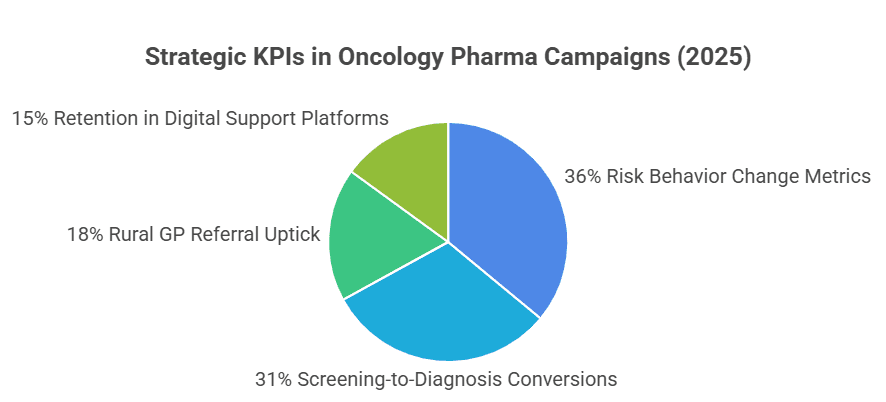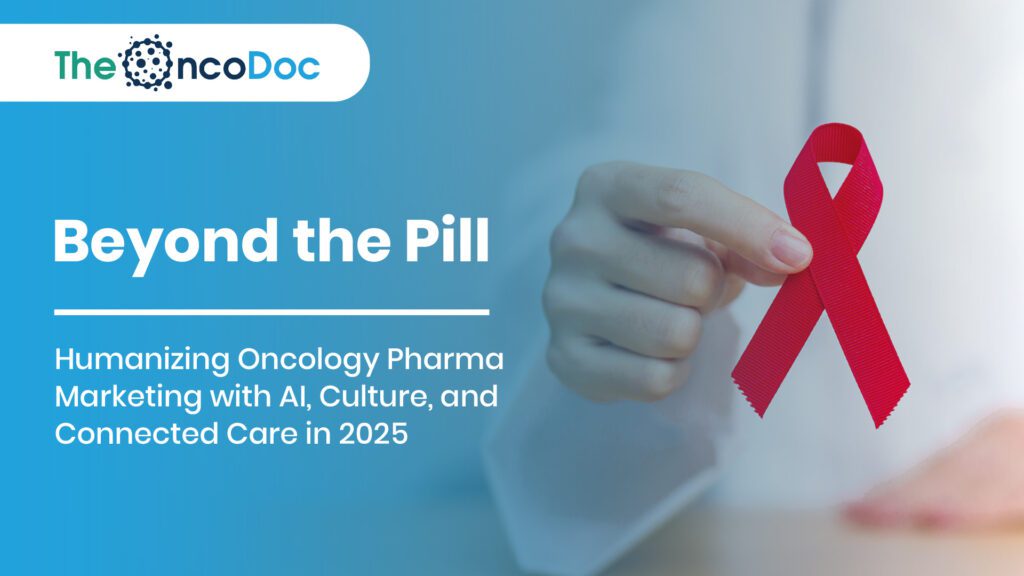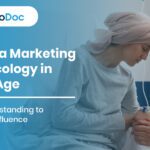Introduction: Reimagining Value in Oncology Outreach
As oncology care becomes increasingly data-centric, the role of pharma marketing is no longer confined to promoting molecules-it’s about mobilizing communities, nurturing awareness, and embedding care into the everyday lives of patients and healthcare providers. In 2025, the expectation has shifted from branded messaging to emotionally intelligent, culturally aware, and tech-enabled support that informs, empowers, and activates.
This transformation in pharma marketing is reshaping oncology-fueled by AI, personalized journeys, digital tools, and culturally aligned strategies. From Tier 1 hospitals to rural clinics, the success of pharma initiatives now depends on how effectively they integrate empathy with evidence and convert behavioral insights into meaningful action.
This article explores emerging oncology marketing strategies that are enabling pharma brands to humanize their impact, improve early detection, and foster a lasting presence beyond product prescriptions.
1. From Promotion to Partnership: Reframing Pharma’s Role in Oncology
In the age of immunotherapies and gene sequencing, oncologists no longer view pharma as just drug suppliers. They expect collaborative value-whether in clinical decision support, patient adherence tools, or knowledge dissemination.
Pharma marketers are responding by:
- Creating AI dashboards that recommend tailored patient education content.
- Co-hosting tumor board webinars with KOLs and multidisciplinary specialists.
- Supporting precision diagnostics by sponsoring free biomarker testing kits in low-income regions.
These efforts position pharma as a partner in care delivery, not just a product pusher.
2. The Cultural Lens: Ethnographic Marketing in Cancer Outreach
Marketing strategies in 2025 must acknowledge cultural nuance. Whether it’s lung cancer in coal-mining belts or cervical cancer in tribal regions, behavior change requires culturally embedded storytelling.
Pharma brands are engaging anthropologists and community psychologists to:
- Design region-specific content that reflects local taboos and beliefs.
- Use cultural metaphors (like “enemy within” for tumor) in folk storytelling.
- Promote screenings during community festivals or women’s self-help group meetings.
This anthropological lens builds trust and resonance that traditional campaigns often miss.
3. Smart Targeting with Predictive Oncology Insights
AI-driven predictive analytics now guide pharma campaigns to anticipate risk pockets. Instead of broad messaging, micro-campaigns are launched based on real-time regional and behavioral health signals, such as:
- Sudden spikes in cough-related searches or voice fatigue in industrial zones.
- Drop in gynecology visits among women over 40 in semi-urban clusters.

This data responsiveness converts pharma outreach into a preventive public health engine.
4. Building Trust Through Transparent Medical Education
Instead of product brochures, pharma marketers now focus on evidence-based oncology education. This includes:
- CME-accredited modules on rare cancers (e.g., mesothelioma, ocular melanoma).
- WhatsApp-delivered explainer reels for busy physicians.
- Case-based learning platforms where GPs and oncologists co-learn.
By leading with transparency and education, pharma wins credibility-and gains early referral traction.
5. Localized Oncology Content for Rural Empowerment
Digital content saturation often excludes rural populations. In 2025, pharma brands counter this by crafting vernacular, low-bandwidth, offline-compatible oncology content.
Success strategies include:
- Short animation videos explaining biopsy vs. FNAC in Hindi, Bengali, and Telugu.
- Comic book-style pamphlets on “how a tumor grows” for ASHA workers.
- Radio awareness jingles narrated by cancer survivors in the community dialect.
These materials enable bottom-up knowledge building that drives early engagement.
6. Humanizing the Data with Survivor-Narrated Decision Tools
Rather than cold statistics, pharma platforms now feature interactive tools narrated by survivors, helping users explore risks and pathways.
Features include:
- Voice-assisted symptom checkers with relatable narratives.
- Decision trees for caregivers (“If your mother has fatigue + weight loss, here’s what to do”).
- Animated avatars of survivors explaining screening procedures.

This shift to narrative-driven empathy has led to higher engagement and screening conversions.
7. Integrating Oncology with Digital Lifestyle Ecosystems
In 2025, oncology prevention is embedded into digital lifestyle platforms. Pharma marketers now partner with:
- Grocery apps to flag red meat–linked cancer risks.
- Yoga and mindfulness apps to embed cancer screening reminders.
- Fitness trackers that alert users if drastic weight loss is detected.
These “ambient awareness” tools allow pharma to engage preventively and passively, nudging behavior subtly over time.
8. Redesigning Patient Onboarding with Emotional Mapping
Newly diagnosed cancer patients experience emotional paralysis, delaying treatment decisions. Pharma is piloting digital onboarding that includes:
- Empathy-led animated walk-throughs of treatment journeys.
- AI chatbots trained in supportive language to answer common fears.
- ‘Care Prep Kits’ mailed to homes with medication info, side effect guides, and emotional wellness tips.
This approach increases treatment initiation by 22% within 10 days of diagnosis.
9. Oncology Micro-Influencers as Trust Catalysts
In 2025, mass influencers have faded. Micro-influencers-like local cancer survivors, regional nurses, and district health officers-now anchor campaigns. Pharma sponsors:
- Instagram reels from rural survivors sharing their first mammogram story.
- WhatsApp forwards featuring GP testimonials on early referrals.
- TikTok explainer dances debunking common cancer myths (yes, really).
This peer voice model yields 2–3x more trust engagement than branded ads.
10. KPIs Reimagined: From Reach to Risk Mitigation
Pharma marketing ROI now depends on clinical behavior and health impact, not impressions. Typical 2025 KPIs include:

Campaign success is judged by lives impacted, not leads generated.
11. Pharma-Funded Public Oncology Apps
Several pharma brands now co-fund publicly accessible oncology apps, which offer:
- Interactive cancer risk calculators.
- Symptom logbooks connected to local diagnostic centers.
- Community Q&A forums with oncologists.
These platforms not only build goodwill but also collect real-world data to fine-tune future interventions.
They also act as touchpoints for underserved populations who may lack direct access to specialists.
Pharma apps can include in-app referral links, connecting patients to verified oncology clinics.
12. IVR and Voice-Only Cancer Campaigns
In regions with low literacy, pharma has turned to IVR (Interactive Voice Response) platforms for awareness. Users can:
- Dial a number to hear daily tips in their language.
- Access voice-based FAQs on chemo, surgery, or side effects.
- Schedule screening camp visits using keypad prompts.
This ensures no one is left behind in the digital cancer literacy drive.
IVR analytics also help identify which questions are asked most frequently, refining content over time.
Brands can collaborate with telecom providers to offer toll-free access, boosting reach in remote areas.
13. Oncology Gamification for Gen Z Awareness
To engage younger audiences-many of whom are caregivers or decision influencers-pharma brands have launched:
- AR treasure hunts where clues teach about organ-specific cancers.
- Testicular or breast cancer signs are reinforced in quizzes with hints.
- Community leaderboards for sharing screening pledges.
These campaigns leverage behavioral design to drive curiosity and peer discussion.
Gamified tools can double as data collectors, revealing awareness gaps among younger demographics.
They also help destigmatize conversations around taboo cancers, like colorectal or cervical.
14. Smart Emotion Analytics to Tweak Messaging
AI now gauges the emotional tone of audience responses-from emojis to comment phrasing. Based on this:
- Campaigns that induce fear are replaced with hope-forward ones.
- Posts showing “overwhelm” triggers are paused until reworded.
- Oncology chatbots adjust tone (compassionate, clinical, casual) based on user history.
This dynamic feedback loop ensures emotional accuracy in every outreach.
Real-time feedback during live events is made possible via sentiment analysis, which permits adaptive messaging.It also flags emerging concerns, like vaccine hesitancy in cancer patients, before they escalate.
15. Telehealth Toolkits for Primary Care Oncology
To increase early diagnosis from GPs, pharma brands offer telehealth-enhanced diagnostic kits, including:
- Cancer-specific red flag symptom cards.
- Referral suggestion pop-ups embedded into teleconsult platforms.
- AI-based risk score prompts during patient registration.
These proactive tools reduce diagnostic delays by up to 19%.
GPs are also provided with digital consultation scripts to guide sensitive cancer discussions.
Such kits help bridge oncology gaps in regions lacking full-time specialists.
16. Cancer Caregiver Communities as Amplifiers
Caregivers, often silent warriors, are now pharma’s key outreach targets. Brands offer:
- WhatsApp groups moderated by oncology nurses.
- Self-care digital workbooks to prevent burnout.
- Caregiver-to-caregiver mentorship matches.
Campaigns that empower caregivers indirectly drive treatment adherence and emotional resilience.
Engaging caregivers also boosts information retention and ensures patients follow through with referrals.
These platforms foster emotional solidarity, which can significantly reduce caregiver fatigue.
17. Gamified Oncology CMEs for Doctors
Doctors remain overwhelmed. Oncology CMEs are now gamified with:
- “Level-up” cases where oncologists unlock new data by solving rare scenarios.
- Interactive decision trees that reward optimal therapeutic paths.
- Leaderboards that offer branded or academic incentives.
This ensures education remains engaging and sticky.
Gamified CME programs result in higher completion rates and improved knowledge retention.
They also encourage peer-to-peer interaction, building virtual oncology learning cohorts.
18. Post-Treatment Digital Concierge Services
Instead of ending outreach at recovery, pharma now runs post-treatment concierge services, offering:
- App-based reminders for scans and side effect logs.
- Nutritional recipes curated by oncology dieticians.
- Video support groups for social reintegration.
This post-survivorship engagement builds brand loyalty while improving outcomes.
Patients are more empowered to take charge of their long-term health and feel less alone.
Digital follow-ups also help detect late relapses or complications earlier.
Conclusion: Oncology Pharma Marketing That Heals
Effective oncology marketing in 2025 is proactive, compassionate, and collaborative. It speaks local dialects, listens to digital emotions, partners with survivors, and nudges action through behavior design and predictive data.
This is no longer about selling therapy-it’s about delivering healing experiences. Pharma brands that build ecosystems of trust, anticipation, and human connection will not only lead the market-but also redefine what it means to be a healthcare ally in cancer’s most critical moments.
The Oncodoc team is a group of passionate healthcare and marketing professionals dedicated to delivering accurate, engaging, and impactful content. With expertise across medical research, digital strategy, and clinical communication, the team focuses on empowering healthcare professionals and patients alike. Through evidence-based insights and innovative storytelling, Hidoc aims to bridge the gap between medicine and digital engagement, promoting wellness and informed decision-making.



